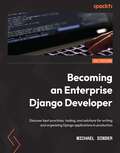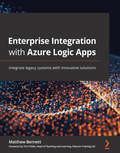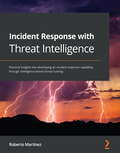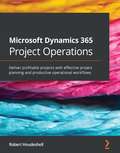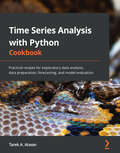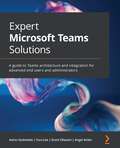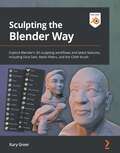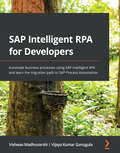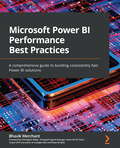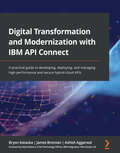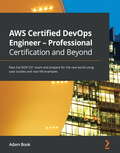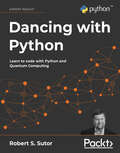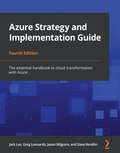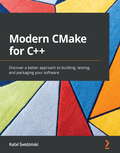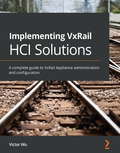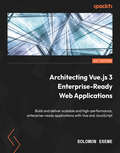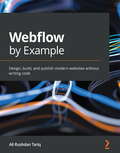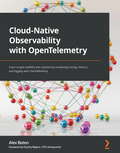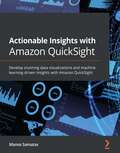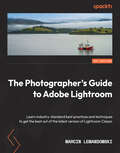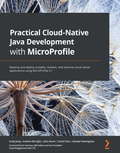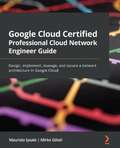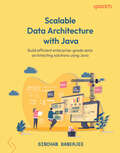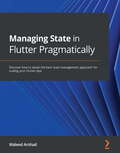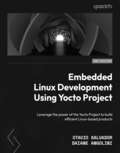- Table View
- List View
Becoming an Enterprise Django Developer: Discover best practices, tooling, and solutions for writing and organizing Django applications in production
by Michael DinderA Python web developer's guide to exploring the Django development lifecycle - beyond the basicsKey FeaturesExpert tips to help you use the right packages, tools, and libraries and understand their scope for your projectGain a thorough understanding of the essential components that comprise a large-scale Python web appLearn best practices for creating a project structure for better performanceBook DescriptionDjango is a powerful framework but choosing the right add-ons that match the scale and scope of your enterprise projects can be tricky. This book will help you explore the multifarious options available for enterprise Django development. Countless organizations are already using Django and more migrating to it, unleashing the power of Python with many different packages and dependencies, including AI technologies. This practical guide will help you understand practices, blueprints, and design decisions to put Django to work the way you want it to. You'll learn various ways in which data can be rendered onto a page and discover the power of Django for large-scale production applications. Starting with the basics of getting an enterprise project up and running, you'll get to grips with maintaining the project throughout its lifecycle while learning what the Django application lifecycle is. By the end of this book, you'll have learned how to build and deploy a Django project to the web and implement various components into the site.What you will learnUse Django to develop enterprise-level apps to help scale your businessUnderstand the steps and tools used to scale up a proof-of-concept project to production without going too deep into specific technologiesExplore core Django components and how to use them in different ways to suit your app's needsFind out how Django allows you to build RESTful APIsExtract, parse, and migrate data from an old database system to a new system with Django and PythonWrite and run a test using the built-in testing tools in DjangoWho this book is forThis book is for Django developers who want to learn the full-stack enterprise app development lifecycle. If you are a Python web developer looking to learn how to maintain a production website and explore Django beyond the basics, this book is for you. The book assumes intermediate-level knowledge of Python programming and the Django framework.
Enterprise Integration with Azure Logic Apps: Integrate legacy systems with innovative solutions
by Matthew Bennett Tim ChildeLearn how to create sophisticated and reliable Logic Apps with improved UXKey FeaturesBecome an Azure Master and create data flows within a matter of minutesPerform transfers using Logic Apps with prompt resultsCreate powerful Logic Apps by enhancing your systems to improve user experienceBook DescriptionLogic Apps are a visual flowchart-like representation of common programming actions, and are a flexible way to create logic without writing a single line of code. Enterprise Integration with Azure Logic Apps is a comprehensive introduction for anyone new to Logic Apps which will boost your learning skills and allow you to create rich, complex, structured, and reusable logic with instant results.You'll begin by discovering how to navigate the Azure portal and understand how your objects can be zoned to a specific environment by using resource groups. Complete with hands-on tutorials, projects, and self-assessment questions, this easy-to-follow guide will teach you the benefits and foundations of Logic App logic design. As you advance, you'll find out how to manage your Azure environment in relation to Logic Apps and how to create elegant and reliable Logic Apps. With useful and practical explanations of how to get the most out of Logic App actions and triggers, you'll be able to ensure that your Logic Apps work efficiently and provide seamless integration for real-world scenarios without having to write code.By the end of this Logic Apps book, you'll be able to create complex and powerful Logic Apps within minutes, integrating large amounts of data on demand, enhancing your systems, and linking applications to improve user experience.What you will learnUnderstand how to use blades, overview pages, and subscription pagesDiscover how to create a Microsoft account to manage your tenantUse a Visual Studio subscription with Azure to manage your Logic AppsFind out how to manage the cloud by analyzing runs, executions, and costsCreate resource groups to zone your enterprise environmentsSupport a development life cycle from sandbox through to productionWho this book is forIf you are an aspiring infrastructure technician who already uses Azure in place of on-premises solutions and is now looking to link systems together, then this book is for you. This book is also for developers interested in systems integration where legacy systems may not have a direct data link and the cloud is the intermediary step. Power users with existing IT skills and experience with Power BI and Power Automate will also find this book useful.
Incident Response with Threat Intelligence: Practical insights into developing an incident response capability through intelligence-based threat hunting
by Roberto MartinezLearn everything you need to know to respond to advanced cybersecurity incidents through threat hunting using threat intelligenceKey FeaturesUnderstand best practices for detecting, containing, and recovering from modern cyber threatsGet practical experience embracing incident response using intelligence-based threat hunting techniquesImplement and orchestrate different incident response, monitoring, intelligence, and investigation platformsBook DescriptionWith constantly evolving cyber threats, developing a cybersecurity incident response capability to identify and contain threats is indispensable for any organization regardless of its size. This book covers theoretical concepts and a variety of real-life scenarios that will help you to apply these concepts within your organization.Starting with the basics of incident response, the book introduces you to professional practices and advanced concepts for integrating threat hunting and threat intelligence procedures in the identification, contention, and eradication stages of the incident response cycle. As you progress through the chapters, you'll cover the different aspects of developing an incident response program. You'll learn the implementation and use of platforms such as TheHive and ELK and tools for evidence collection such as Velociraptor and KAPE before getting to grips with the integration of frameworks such as Cyber Kill Chain and MITRE ATT&CK for analysis and investigation. You'll also explore methodologies and tools for cyber threat hunting with Sigma and YARA rules.By the end of this book, you'll have learned everything you need to respond to cybersecurity incidents using threat intelligence.What you will learnExplore the fundamentals of incident response and incident managementFind out how to develop incident response capabilitiesUnderstand the development of incident response plans and playbooksAlign incident response procedures with business continuityIdentify incident response requirements and orchestrate people, processes, and technologiesDiscover methodologies and tools to integrate cyber threat intelligence and threat hunting into incident responseWho this book is forIf you are an information security professional or anyone who wants to learn the principles of incident management, first response, threat hunting, and threat intelligence using a variety of platforms and tools, this book is for you. Although not necessary, basic knowledge of Linux, Windows internals, and network protocols will be helpful.
Microsoft Dynamics 365 Project Operations: Deliver profitable projects with effective project planning and productive operational workflows
by Robert HoudeshellDiscover the endless capabilities and end-to-end project management functionalities of Dynamics 365 Project Operations to drive your firm's project success and ensure rapid business growth in the competitive digital economic worldKey FeaturesDeliver successful projects via improved collaboration, visibility, and teamwork using Microsoft Project Operations solutionsGain real-time data insights to modernize business strategies to increase market shareBuild the right project operations models to meet business needs with an optimized budgetBook DescriptionDynamics 365 Project Operations is a game-changing solution set for project-driven businesses that allows you to deliver commercially successful projects in a timely and cost-effective manner, keeping the project teams productive and collaborative. With this book, you'll find out how you can bring more value to the business by winning new projects and driving exponential revenue growth. Starting with the key principles of Project Operations, you'll understand how it improves project planning and execution. You'll then learn how to successfully deploy Project Operations along with different integration strategies and get to grips with the best approach for sales through project opportunities, project contracts, and pricing workflow implementation. This book will guide you through setting up direct staffing and centralized staffing models and enable you to manage project changes confidently by getting hands-on with project timeline management, pricing management, resource assignments, and modifications. In the final chapters, you'll find out how to use Project Operations effectively for project accounting and finance. By the end of this book, you'll have gained the confidence to deliver profitable projects in a well-connected organization through efficient decision-making and successful customer-client relationships.What you will learnConfigure key elements of Project Operations to drive improved collaboration with your customersDiscover how Project Operations is interconnected with Microsoft 365 and Dynamics 365 PlatformUnderstand the Project Opportunity-to-Quote-to-Contract workflow and its implications for sellingFind out how to set up and utilize direct staffing and centralized staffing modelsExplore Project Timeline Management using Task, Board, and Timeline viewsFind out how information flows to finance and operations in Project OperationsWho this book is forThis book is for project managers, project leads, business consultants, and business leaders who want to gain a competitive edge by delivering successful projects in a shorter time span with the help of effective operations and workflows across different teams within projects. Knowledge of Microsoft 365 and a sound understanding of business acumen and sales through the delivery process is necessary to get the most out of this book.
Time Series Analysis with Python Cookbook: Practical recipes for exploratory data analysis, data preparation, forecasting, and model evaluation
by Tarek A. AtwanPerform time series analysis and forecasting confidently with this Python code bank and reference manualKey FeaturesExplore forecasting and anomaly detection techniques using statistical, machine learning, and deep learning algorithmsLearn different techniques for evaluating, diagnosing, and optimizing your modelsWork with a variety of complex data with trends, multiple seasonal patterns, and irregularitiesBook DescriptionTime series data is everywhere, available at a high frequency and volume. It is complex and can contain noise, irregularities, and multiple patterns, making it crucial to be well-versed with the techniques covered in this book for data preparation, analysis, and forecasting. This book covers practical techniques for working with time series data, starting with ingesting time series data from various sources and formats, whether in private cloud storage, relational databases, non-relational databases, or specialized time series databases such as InfluxDB. Next, you'll learn strategies for handling missing data, dealing with time zones and custom business days, and detecting anomalies using intuitive statistical methods, followed by more advanced unsupervised ML models. The book will also explore forecasting using classical statistical models such as Holt-Winters, SARIMA, and VAR. The recipes will present practical techniques for handling non-stationary data, using power transforms, ACF and PACF plots, and decomposing time series data with multiple seasonal patterns. Later, you'll work with ML and DL models using TensorFlow and PyTorch. Finally, you'll learn how to evaluate, compare, optimize models, and more using the recipes covered in the book.What you will learnUnderstand what makes time series data different from other dataApply various imputation and interpolation strategies for missing dataImplement different models for univariate and multivariate time seriesUse different deep learning libraries such as TensorFlow, Keras, and PyTorchPlot interactive time series visualizations using hvPlotExplore state-space models and the unobserved components model (UCM)Detect anomalies using statistical and machine learning methodsForecast complex time series with multiple seasonal patternsWho this book is forThis book is for data analysts, business analysts, data scientists, data engineers, or Python developers who want practical Python recipes for time series analysis and forecasting techniques. Fundamental knowledge of Python programming is required. Although having a basic math and statistics background will be beneficial, it is not necessary. Prior experience working with time series data to solve business problems will also help you to better utilize and apply the different recipes in this book.
Expert Microsoft Teams Solutions: A guide to Teams architecture and integration for advanced end users and administrators
by Aaron Guilmette Yura Lee Grant Oliasani Angel AvilesWritten by Microsoft engineers, Expert Microsoft Teams Solutions covers in-depth topics in Teams that are not covered elsewhere and explores tasks that customers frequently rely on Microsoft Partners to accomplishKey FeaturesExtend the MS Teams experience with this practical guide from Microsoft's technical specialistsDiscover advanced Teams capabilities such as voice, governance, and Power Platform integrationGet to grips with planning resources for voice integration in TeamsBook DescriptionMicrosoft Teams is designed to improve collaboration and integrate components of SharePoint, Exchange, Power Platform, and voice calling into a single platform. Complete with step-by-step explanations of concepts, practical examples, and architecture guidance, you'll learn how to plan and deploy Teams for your organization. As you progress, you'll explore and understand the Teams platform as a whole, from architecture and collaboration through to apps and voice, with the help of examples. The book approaches Teams not only from an end-user perspective but also from an administrator's point of view. You'll be able to understand the challenges around modernization in your organization relating to adopting, implementing, and administering Teams and tackle them effectively. By helping you realize the potential of Teams as a platform, this book will enable you to set up and deploy Teams solutions, leading to modernization in your organization's chat and voice infrastructure. By the end of this book, you'll be able to design and implement the most important and exciting aspects of Microsoft Teams.What you will learnGain a clear understanding of Microsoft Teams architecture and deployment conceptsBecome well-versed with advanced Teams voice capabilitiesExplore best practices to extend the Teams experience to various apps through collaborationFocus on how to conduct effective meetings, including ad hoc, scheduled, channel, and live eventsIntegrate Power Apps and Power Automate with Microsoft TeamsUnderstand key governance and security concepts in administering Microsoft TeamsWho this book is forThe book is for intermediate-level and experienced Microsoft Teams IT professionals as well as for administrator roles. Intermediate-level knowledge of the Microsoft Teams platform is assumed.
Sculpting the Blender Way: Explore Blender's 3D sculpting workflows and latest features, including Face Sets, Mesh Filters, and the Cloth brush
by Xury GreerGet started with the latest sculpting features in Blender 3D and learn key sculpting workflows such as Dynotopo, Voxel Remesher, QuadriFlow, and MultiresolutionKey FeaturesUse Blender's core sculpting workflows: basic sculpting, Dynotopo, Voxel Remesher, QuadriFlow, and MultiresolutionLearn how to use and customize Blender's sculpting brushes to create fantastic art effortlesslyExplore common techniques in Blender 3.0 for creating facial features, clothing, accessories, and moreBook DescriptionBlender 3D is a free and open source program that can be used for every part of the 3D production pipeline. It has several robust feature sets for creating 3D art that have contributed to its rising popularity in the last few years. Sculpting is perhaps the most enjoyable and artistic method for creating 3D art as it relies less on technical knowledge and focuses on artistic brushes. The latest release of Blender makes the sculpting feature set more powerful than ever, so now is an excellent time to learn it! This book covers the expansive list of features in the Blender 2.93 LTS release, as well as the exciting all-new Blender 3.0 release. This book will be an excellent resource for professionals who need a production-ready long-term support release of the software, as well as hobbyists looking for a cutting-edge experience.Sculpting the Blender Way will demonstrate how to navigate Blender's user interface and take you through the core workflows. You'll gain a detailed understanding of how the sculpting features work, including basic sculpting, Dyntopo, the Voxel Remesher, QuadriFlow, and Multiresolution. This Blender book will cover a wide range of brushes, as well as all of the latest additions to the sculpting feature set, such as Face Sets, Mesh Filters, and the Cloth brush. You'll learn how to customize these brushes and features to create fantastic 3D sculptures that you can share with the ever-growing Blender community.By the end of this book, you'll have gained a complete understanding of the core sculpting workflows and be able to use Blender to bring your digital characters to life.What you will learnConfigure your graphics tablet for use in 3D sculptingSet up Blender's user interface for sculptingUnderstand the core sculpting workflowsGet the hang of using Blender's basic sculpting brushesCustomize brushes for more advanced workflowsExplore high-resolution details with brush alphas and MultiresolutionTry out the all-new Cloth brushRender your finished artwork for your portfolioWho this book is forThis book is for artists who want to get started with the exciting new sculpting features in Blender 3D. Whether you have experience using ZBrush or traditional sculpting, or are completely new to sculpting, this book will have something new for you to learn. Prior experience with Blender or other 3D software may be helpful but is not required. However, a graphics tablet from Wacom, XP-Pen, or Huion is highly recommended to be able to follow along the concepts and examples covered in the book.
SAP Intelligent RPA for Developers: Automate business processes using SAP Intelligent RPA and learn the migration path to SAP Process Automation
by Vishwas Madhuvarshi Vijaya Kumar GanugulaBuild intelligent bots with a low-code design studio from SAP to automate repetitive manual processes and thus save precious labor hours and improve the business process efficiencyKey FeaturesPerform quick integration with an older system where building a standard integration might be too expensiveAvoid erroneous data caused by inadvertent errors introduced by human actors due to lack of checksIncrease productivity by working on high-value-added activitiesBook DescriptionSAP Intelligent Robotic Process Automation (RPA) enables businesses to automate repetitive work and integrate automation capabilities across SAP and non-SAP systems.This book provides end-to-end coverage of business process automation using SAP Intelligent RPA and shows how to build multiple SAP Intelligent RPA projects from start to finish. Some of these projects may build upon the work done in previous chapters to showcase the Agile development process in SAP Intelligent RPA.As you progress, you'll cover the SAP Intelligent RPA factory, Desktop Studio, Cloud Studio, and the Bot store. You'll also learn about the building blocks of the SAP Intelligent RPA solution and creating bots from initial application declaration to workflow design and deployment, along with making bots run in attended and unattended modes. You'll also learn about SAP Process Automation, the new SAP service that is going to replace the SAP Intelligent RPA service soon. Finally, we will discuss the migration path for your SAP Intelligent RPA projects to SAP Process Automation and showcase that the RPA development remains similar in both services. By the end of this RPA book, you'll be able to create and manage complex bots that are capable of interacting with SAP and non-SAP systems.What you will learnUnderstand RPA and the broad context that RPA operates inExplore the low-code, no-code, and pro-code capabilities offered by SAP Intelligent RPA 2.0Focus on bot development, testing, deployment, and configuration using SAP Intelligent RPAGet to grips with SAP Intelligent RPA 2.0 components and explore the product development roadmapDebug your project to identify the probable reasons for errors and remove existing and potential bugsUnderstand security within SAP Intelligent RPA, authorization, roles, and authenticationWho this book is forThis book is for developers and business users who are interested in learning SAP Intelligent RPA for automation of non-value-added, monotonous, and error-prone work. A basic understanding of JavaScript programming is required to engage in pro-code development for addressing complex challenges.
Microsoft Power BI Performance Best Practices: A comprehensive guide to building consistently fast Power BI solutions
by Bhavik Merchant Christopher WebbSupercharge performance analytics and create repeatable patterns to ensure you get the best performance and scalability from your analytics solutions with Power BIKey FeaturesLearn how to build performant data models and apply Row-Level SecurityIdentify and fix performance issues in reports, DAX, and datasets using DAX Studio/VertiPaq AnalyzerUse a formal process to manage performance, from setting targets to monitoring and remediating issuesBook DescriptionThis book comprehensively covers every layer of Power BI, from the report canvas to data modeling, transformations, storage, and architecture.Developers and architects working with any area of Power BI will be able to put their knowledge to work with this practical guide to design and implement at every stage of the analytics solution development process. This book is not only a unique collection of best practices and tips, but also provides you with a hands-on approach to identifying and fixing common performance issues.Complete with explanations of essential concepts and practical examples, you'll learn about common design choices that affect performance and consume more resources and how to avoid these problems. You'll grasp the general architectural issues and settings that broadly affect most solutions. As you progress, you'll walk through each layer of a typical Power BI solution, learning how to ensure your designs can handle scale while not sacrificing usability. You'll focus on the data layer and then work your way up to report design. We will also cover Power BI Premium and load testing.By the end of this Power BI book, you'll be able to confidently maintain well-performing Power BI solutions with reduced effort and know how to use freely available tools and a systematic process to monitor and diagnose performance problems.What you will learnUnderstand how to set realistic performance targets and address performance proactivelyUnderstand how architectural options and configuration affect performanceBuild efficient Power BI reports and data transformationsExplore best practices for data modeling, DAX, and large datasetsUnderstand the inner workings of Power BI PremiumExplore options for extreme scale with Azure servicesUnderstand how to use tools that help identify and fix performance issuesWho this book is forData analysts, BI developers, and data professionals who have learnt the basics of Power BI and now want to understand how to build advanced analytics solutions will find this business intelligence book useful. Familiarity with the major components of Power BI and a beginner-level understanding of their purpose and use cases are required.
Digital Transformation and Modernization with IBM API Connect: A practical guide to developing, deploying, and managing high-performance and secure hybrid-cloud APIs
by Bryon Kataoka James Brennan Ashish Aggarwal Matt RobertsSuccessfully execute a strategic roadmap of digital transformation and modernize your enterprise with a proven API-led agile implementation approach by unlocking the full range of features in IBM API Connect Version 10Key FeaturesExplore techniques to design and deliver valuable customer-centric APIs using API ConnectManage your APIs with improved security and optimal performance across many channelsUncover hidden capabilities that help improve business agility and management within your API ecosystemBook DescriptionIBM API Connect enables organizations to drive digital innovation using its scalable and robust API management capabilities across multi-cloud and hybrid environments. With API Connect's security, flexibility, and high performance, you'll be able to meet the needs of your enterprise and clients by extending your API footprint. This book provides a complete roadmap to create, manage, govern, and publish your APIs. You'll start by learning about API Connect components, such as API managers, developer portals, gateways, and analytics subsystems, as well as the management capabilities provided by CLI commands. You'll then develop APIs using OpenAPI and discover how you can enhance them with logic policies. The book shows you how to modernize SOAP and FHIR REST services as secure APIs with authentication, OAuth2/OpenID, and JWT, and demonstrates how API Connect provides safeguards for GraphQL APIs as well as published APIs that are easy to discover and well documented. As you advance, the book guides you in generating unit tests that supplement DevOps pipelines using Git and Jenkins for improved agility, and concludes with best practices for implementing API governance and customizing API Connect components. By the end of this book, you'll have learned how to transform your business by speeding up the time-to-market of your products and increase the ROI for your enterprise.What you will learnUse API Connect to create, manage, and publish customer-centric, API-led solutionsRun CLI commands to manage API configuration and deploymentsCreate REST, SOAP, and GraphQL APIs securely using OpenAPISupport OAuth and JWT security methods using policiesCreate custom policies to supplement securityApply built-in policies to transform payloadsUse CLIs and unit testing hooks within DevOps pipelinesFind out how to customize Analytics dashboards and Portal User InterfaceWho this book is forThis book is for developers and architects who want to achieve digital transformation using IBM API Connect and successfully execute the strategic roadmap of enterprise modernization while effectively managing their API ecosystem. A solid understanding of what RESTful services and APIs can do and where to implement API security is necessary to get started. Experience in application development and basic knowledge of microservices, container orchestration, and cloud environments will help you to get the most out of this book.
AWS Certified DevOps Engineer - Professional Certification and Beyond: Pass the DOP-C01 exam and prepare for the real world using case studies and real-life examples
by Adam BookExplore the ins and outs of becoming an AWS certified DevOps professional engineer with the help of easy-to-follow practical examples and detailed explanationsKey FeaturesDiscover how to implement and manage continuous delivery systems and methodologies on AWSExplore real-world scenarios and hands-on examples that will prepare you to take the DOP-C01 exam with confidenceLearn from enterprise DevOps scenarios to prepare fully for the AWS certification examBook DescriptionThe AWS Certified DevOps Engineer certification is one of the highest AWS credentials, vastly recognized in cloud computing or software development industries. This book is an extensive guide to helping you strengthen your DevOps skills as you work with your AWS workloads on a day-to-day basis.You'll begin by learning how to create and deploy a workload using the AWS code suite of tools, and then move on to adding monitoring and fault tolerance to your workload. You'll explore enterprise scenarios that'll help you to understand various AWS tools and services. This book is packed with detailed explanations of essential concepts to help you get to grips with the domains needed to pass the DevOps professional exam. As you advance, you'll delve into AWS with the help of hands-on examples and practice questions to gain a holistic understanding of the services covered in the AWS DevOps professional exam. Throughout the book, you'll find real-world scenarios that you can easily incorporate in your daily activities when working with AWS, making you a valuable asset for any organization.By the end of this AWS certification book, you'll have gained the knowledge needed to pass the AWS Certified DevOps Engineer exam, and be able to implement different techniques for delivering each service in real-world scenarios.What you will learnAutomate your pipelines, build phases, and deployments with AWS-native toolingDiscover how to implement logging and monitoring using AWS-native toolingGain a solid understanding of the services included in the AWS DevOps Professional examReinforce security practices on the AWS platform from an exam point of viewFind out how to automatically enforce standards and policies in AWS environmentsExplore AWS best practices and anti-patternsEnhance your core AWS skills with the help of exercises and practice testsWho this book is forThis book is for AWS developers and SysOps administrators looking to advance their careers by achieving the highly sought-after DevOps Professional certification. Basic knowledge of AWS as well as its core services (EC2, S3, and RDS) is needed. Familiarity with DevOps concepts such as source control, monitoring, and logging, not necessarily in the AWS context, will be helpful.
Dancing with Python: Learn Python software development from scratch and get started with quantum computing
by Robert S. SutorDevelop skills in Python by implementing exciting algorithms, including mathematical functions, classical searching, data analysis, plotting data, machine learning techniques, and quantum circuitsKey FeaturesLearn Python basics to write elegant and efficient codeCreate quantum circuits and algorithms using Qiskit and run them on quantum computing hardware and simulatorsDelve into Python's advanced features, including machine learning, analyzing data, and searchingBook DescriptionCoding is the art and engineering of creating software, and Python has been one of the core coding languages for many years. This introductory Python book helps you learn classical and quantum computing in a unified and practical way. It will help you work with numbers, strings, collections, iterators, and files. The book goes beyond functions and classes and teaches you how to use Python and Qiskit to create gates and circuits for classical and quantum computing. Learn how quantum extends classical techniques using the Grover search algorithm and the code that implements it. Dive into some advanced and widely used applications of Python and revisit strings with more sophisticated tools such as regular expressions and basic natural language processing (NLP). The final chapters introduce you to data analysis, visualizations, and supervised and unsupervised machine learning. By the end of the book, you will be proficient in classical coding and programming using the latest and most powerful quantum computers.What you will learnCreate Python code using numbers, strings, collections, classes, objects, functions, conditionals, loops, and operatorsWrite succinct code the Pythonic way using magic methods, iterators, and generatorsExplore different quantum gates and use them to build quantum circuitsAnalyze data, build basic machine learning models, and plot the resultsSearch for information using traditional methods and the quantum Grover search algorithmOptimize and test your code to run efficientlyWho this book is forThe book is for Python and coding beginners. Basic familiarity with algebra, geometry, trigonometry, and logarithms is required as the book does not cover the detailed mathematics and theory of quantum computing. You can check out the author's Dancing with Qubits book, also published by Packt, for an approachable and comprehensive introduction to quantum computing.
Azure Strategy and Implementation Guide: The essential handbook to cloud transformation with Azure, 4th Edition
by Jack Lee Greg Leonardo Jason Milgram Dave RendonLeverage Azure's cloud capabilities to find the most optimized path to meeting your firm's cloud infrastructure needs.Key FeaturesGet to grips with the core Azure infrastructure technologies and solutionsDevelop the ability to opt for cloud design and architecture that best fits your organizationCover the entire spectrum of cloud migration from planning to implementation and best practicesBook DescriptionMicrosoft Azure is a powerful cloud computing platform that offers a multitude of services and capabilities for organizations of any size moving to a cloud strategy. This fourth edition comes with the latest updates on cloud security fundamentals, hybrid cloud, cloud migration, Microsoft Azure Active Directory, and Windows Virtual Desktop. It encapsulates the entire spectrum of measures involved in Azure deployment that includes understanding Azure fundamentals, choosing a suitable cloud architecture, building on design principles, becoming familiar with Azure DevOps, and learning best practices for optimization and management. The book begins by introducing you to the Azure cloud platform and demonstrating the substantial scope of digital transformation and innovation that can be achieved with Azure's capabilities. The guide also acquaints you with practical insights into application modernization, Azure Infrastructure as a Service (IaaS) deployment, infrastructure management, key application architectures, best practices of Azure DevOps, and Azure automation. By the end of this book, you will have acquired the skills required to drive Azure operations from the planning and cloud migration stage to cost management and troubleshooting. What you will learnUnderstand core Azure infrastructure technologies and solutionsCarry out detailed planning for migrating applications to the cloud with AzureDeploy and run Azure infrastructure servicesDefine roles and responsibilities in DevOpsGet a firm grip on Azure security fundamentalsCarry out cost optimization in AzureWho this book is forThis book is designed to benefit Azure architects, cloud solution architects, Azure developers, Azure administrators, and anyone who wants to develop expertise in operating and administering the Azure cloud. Basic familiarity with operating systems and databases will help you grasp the concepts covered in this book.
Modern CMake for C++: Discover a better approach to building, testing, and packaging your software
by Rafal SwidzinskiWrite comprehensive, professional-standard CMake projects and ensure the quality and simplicity of your solutionsKey FeaturesUnderstand and automate compilation and linking with CMakeManage internal and external dependencies easilyAdd quality checks and tests as an inherent step for your buildsBook DescriptionCreating top-notch software is an extremely difficult undertaking. Developers researching the subject have difficulty determining which advice is up to date and which approaches have already been replaced by easier, better practices. At the same time, most online resources offer limited explanation, while also lacking the proper context and structure. This book offers a simpler, more comprehensive, experience as it treats the subject of building C++ solutions holistically. Modern CMake for C++ is an end-to-end guide to the automatization of complex tasks, including building, testing, and packaging. You'll not only learn how to use the CMake language in CMake projects, but also discover what makes them maintainable, elegant, and clean. The book also focuses on the structure of source directories, building targets, and packages. As you progress, you'll learn how to compile and link executables and libraries, how those processes work, and how to optimize builds in CMake for the best results. You'll understand how to use external dependencies in your project – third-party libraries, testing frameworks, program analysis tools, and documentation generators. Finally, you'll get to grips with exporting, installing, and packaging for internal and external purposes. By the end of this book, you'll be able to use CMake confidently on a professional level.What you will learnUnderstand best practices for building C++ codeGain practical knowledge of the CMake language by focusing on the most useful aspectsUse cutting-edge tooling to guarantee code quality with the help of tests and static and dynamic analysisDiscover how to manage, discover, download, and link dependencies with CMakeBuild solutions that can be reused and maintained in the long termUnderstand how to optimize build artifacts and the build process itselfWho this book is forThe book is for build engineers and software developers with knowledge of C/C++ programming who are looking to learn CMake to automate the process of building small and large software solutions. If you are someone who's just getting started with CMake, a long-time GNU Make user, or simply looking to brush up on the latest best practices, this book is for you.
Implementing VxRail HCI Solutions: A complete guide to VxRail Appliance administration and configuration
by Victor WuPlan, design, deploy, and administer the solutions available in VxRail ApplianceKey FeaturesLearn how to plan and design the VxRail HCI systemUnderstand VxRail's administration, lifecycle management, and cluster scale-outExplore migration methodologies for VxRail systemsBook DescriptionHyper-converged infrastructure (HCI) can help you simplify the provisioning and daily operations of computing and storage. With this book, you'll understand how HCI can offload the day 0 deployment and day-to-day operations of a system administrator. You'll explore the VxRail Appliance, which is an HCI solution that provides lifecycle management, automation, and operational simplicity. Starting with an overview of the VxRail Appliance system architecture and components, you'll understand the benefits of the VxRail system and compare it with the environment of traditional servers and storage. As you advance, the book covers topics such as disaster recovery and active-active and active-passive solutions for VxRail. By the end of this book, you'll have gained the confidence to manage the deployment, administration, planning, and design of a VxRail system.What you will learnSet up the hardware and software requirements for a VxRail installationMonitor the status of VxRail appliances with the VxRail Manager pluginGet to grips with all the administration interfaces used to manage the VxRail applianceUnderstand vCenter roles and permissions management in the VxRail clusterDiscover best practices for vSAN configuration in the VxRail clusterFind out about VxRail cluster scale-out rules and how to expand the VxRail clusterDeploy active-passive solutions for VxRail with VMware Site Recovery Manager (SRM)Who this book is forIf you are a system architect, system administrator, or consultant involved in planning and deploying VxRail HCI or want to learn how to use VxRail HCI, then this book is for you. Equivalent knowledge and administration experience with ESXi and vCenter Server will be helpful.
Architecting Vue.js 3 Enterprise-Ready Web Applications: Build and deliver scalable and high-performance, enterprise-ready applications with Vue and JavaScript
by Solomon EsemeA comprehensive, best-practices guide to building Vue.js apps that can scale along with your businessPurchase of the print or Kindle book includes a free PDF eBookKey FeaturesImplement Vue.js 3 to create Vue.js application with improved performanceExplore the Vue.js 3 composition API in-depth while building your enterprise applicationEnsure the scalability and maintainability of your apps with different types of testingBook DescriptionBuilding enterprise-ready Vue.js apps entails following best practices for creating high-performance and scalable applications. Complete with step-by-step explanations and best practices outlined, this Vue.js book is a must-read for any developer who works with a large Vue.js codebase where performance and scalability are indispensable.Throughout this book, you'll learn how to configure and set up Vue.js 3 and the composition API and use it to build real-world applications. You'll develop the skills to create reusable components and scale performance in Vue.js 3 applications. As you progress, the book guides you in scaling performance with asynchronous lazy loading, image compression, code splitting, and tree shaking. Furthermore, you'll see how to use the Restful API, Docker, GraphQL, and different types of testing to ensure that your Vue.js 3 application is scalable and maintainable.By the end of this book, you'll be well-versed in best practices for implementing Restful API, Docker, GraphQL, and testing methods to build and deploy an enterprise-ready Vue.js 3 application of any scale.What you will learnScale your app's performance in Vue.js 3 using best practicesImplement testing strategies for large-scale Vue.js codebaseManage large file structures using the micro frontend architectureDiscover the industry standard to Dockerize and deploy an enterprise Vue.js 3 web applicationUse GraphQL to deliver scalable and high-performing applicationsExplore various testing libraries and how to integrate them with Vue.js 3Who this book is forThe Vue.js 3 book is for Vue.js developers and professional frontend developers who want to build high-performance, production-grade, and highly scalable enterprise Vue.js apps from design to deployment. The book assumes working knowledge of Vue.js and JavaScript programming.
Webflow by Example: Design, build, and publish modern websites without writing code
by Ali Rushdan TariqBuild modern responsive websites without writing code by making the most of the power and flexibility of WebflowKey FeaturesGet to grips with Webflow to build and launch responsive websites from scratchLearn how to put Webflow into practice and take advantage of its power and flexibilityBuild your own modern responsive websites from scratch and without any codeBook DescriptionWebflow is a modern no-code website-builder that enables you to rapidly design and build production-scale responsive websites. Webflow by Example is a practical, project-based, and beginner-friendly guide to understanding and using Webflow to efficiently build and launch responsive websites from scratch.Complete with hands-on tutorials, projects, and self-assessment questions, this easy-to-follow guide will take you through modern web development principles and help you to apply them efficiently using Webflow. You'll also get to grips with modern responsive web development and understand how to take advantage of the power and flexibility of Webflow. The book will guide you through a real-life project where you will build a fully responsive and dynamic website from scratch. You will learn how to add animations and interactions, customize experiences for users, and more. Finally, the book covers important steps and best practices for making your website ready for production, including SEO optimization and how to publish and package the website.By the end of this Webflow book, you will have gained the skills you need to build modern responsive websites from scratch without any code.What you will learnBuild and customize websites without any codeUnderstand how to approach designing and developing for the modern webBecome familiar with the main functionalities of WebflowFollow best practices for Webflow development while working on a practical project, from its design to launchHarness the power of the Webflow CMS to create dynamic contentAdd modern flourishes to a website using pre-defined and custom animations and interactionsWho this book is forIf you're an entrepreneur, web designer, or anyone with little web development knowledge, this book will help you learn how to build fully responsive websites and web prototypes without writing a single line of code. If you're a web designer, this book will make you a more informed web developer. If you're already a developer, this book will help you become a better web designer.
Cloud-Native Observability with OpenTelemetry: Learn to gain visibility into systems by combining tracing, metrics, and logging with OpenTelemetry
by Alex Boten Charity MajorsLeverage OpenTelemetry's API, libraries, tools and the collector to produce and collect telemetry along with using open-source tools to analyze distributed traces, check metrics and logs, and gain insights into application healthKey FeaturesGet to grips with OpenTelemetry, an open-source cloud-native software observability standardUse vendor-neutral tools to instrument applications to produce better telemetry and improve observabilityUnderstand how telemetry data can be correlated and interpreted to understand distributed systemsBook DescriptionCloud-Native Observability with OpenTelemetry is a guide to helping you look for answers to questions about your applications. This book teaches you how to produce telemetry from your applications using an open standard to retain control of data. OpenTelemetry provides the tools necessary for you to gain visibility into the performance of your services. It allows you to instrument your application code through vendor-neutral APIs, libraries and tools.By reading Cloud-Native Observability with OpenTelemetry, you'll learn about the concepts and signals of OpenTelemetry - traces, metrics, and logs. You'll practice producing telemetry for these signals by configuring and instrumenting a distributed cloud-native application using the OpenTelemetry API. The book also guides you through deploying the collector, as well as telemetry backends necessary to help you understand what to do with the data once it's emitted. You'll look at various examples of how to identify application performance issues through telemetry. By analyzing telemetry, you'll also be able to better understand how an observable application can improve the software development life cycle.By the end of this book, you'll be well-versed with OpenTelemetry, be able to instrument services using the OpenTelemetry API to produce distributed traces, metrics and logs, and more.What you will learnUnderstand the core concepts of OpenTelemetryExplore concepts in distributed tracing, metrics, and loggingDiscover the APIs and SDKs necessary to instrument an application using OpenTelemetryExplore what auto-instrumentation is and how it can help accelerate application instrumentationConfigure and deploy the OpenTelemetry CollectorGet to grips with how different open-source backends can be used to analyze telemetry dataUnderstand how to correlate telemetry in common scenarios to get to the root cause of a problemWho this book is forThis book is for software engineers, library authors, and systems operators looking to better understand their infrastructure, services and applications by leveraging telemetry data like never before. Working knowledge of Python programming is assumed for the example applications that you'll be building and instrumenting using the OpenTelemetry API and SDK. Some familiarity with Go programming, Linux, and Docker is preferable to help you set up additional components in various examples throughout the book.
Actionable Insights with Amazon QuickSight: Develop stunning data visualizations and machine learning-driven insights with Amazon QuickSight
by Manos SamatasBuild interactive dashboards and storytelling reports at scale with the cloud-native BI tool - Amazon QuickSight, including embedded analytics and ML-powered insightsKey FeaturesUnderstand how to set up Amazon QuickSight, manage data sources, and build and share dashboardsLearn the advanced features of Amazon Quicksight to develop interactive and embedded dashboardsManage and monitor dashboards using the QuickSight API and other AWS services such as Amazon CloudTrailBook DescriptionThe adoption of cloud-native BI tools, like Amazon QuickSight, enables organizations to gather insights from data at scale. This book is a practical guide to performing simple-to-advanced tasks with Amazon QuickSight.You'll begin by learning QuickSight's fundamental concepts and how to configure data sources. Next, you'll be introduced to the main analysis-building functionality of QuickSight to develop visuals and dashboards. The book will also demonstrate how to develop and share interactive dashboards with parameters and on-screen controls. Advanced filtering options with URL actions will then be covered, before learning how to set up alerts and scheduled reports. Later, you'll explore the Insights visual type in QuickSight using both existing insights and by building custom insights. Further chapters will show you how to add machine learning insights such as forecasting capabilities, analyzing time series data, adding narratives, and outlier detection to your dashboards. You'll also explore patterns to automate operations and look closer into the API actions that allow us to control settings. Finally, you'll learn advanced topics such as embedded dashboards and multitenancy.By the end of this book, you'll be well-versed with QuickSight's BI and analytics functionalities that will help you create BI apps with ML capabilities.What you will learnUnderstand the wider AWS analytics ecosystem and how QuickSight fits within itSet up and configure data sources with Amazon QuickSightInclude custom controls and add interactivity to your BI application using parametersAdd ML insights such as forecasting, anomaly detection, and narrativesExplore patterns to automate operations using QuickSight APIsCreate interactive dashboards and storytelling with Amazon QuickSightDesign an embedded multi-tenant analytics architectureFocus on data permissions and how to manage Amazon QuickSight operationsWho this book is forThis book is for business intelligence (BI) developers and data analysts who are looking to create interactive dashboards using data from Lake House on AWS with Amazon QuickSight. This book will also be useful for anyone who wants to learn Amazon QuickSight in depth using practical examples. You will need to be familiar with general data visualization concepts, however, no prior experience with Amazon QuickSight is required.
The Photographer's Guide to Adobe Lightroom: Learn industry-standard best practices and techniques to get the best out of the latest version of Lightroom Classic
by Marcin Lewandowski Andrei LopatenkoGet better at Adobe Lightroom to streamline post-production and focus on creativityKey FeaturesManage, edit, and post-produce photographs in one place with the help of this full-color guideAdopt a non-destructive approach to working with seemingly infinite copies of photographs with different looksIncrease productivity and make your creative process easier with Lightroom's functionality and additional toolsBook DescriptionIt takes talent to be a great photographer, but in the digital era, it also takes a level of technical proficiency. Adobe Photoshop Lightroom Classic was designed as a one-stop solution for photographers to perfect their final products on a desktop-focused workflow, which includes local storage of your photos in files and folders on your computer. Knowing how to efficiently navigate through Lightroom means that you'll be able to concentrate on being creative instead of wondering “what does this button do”. Complete with step-by-step explanations of essential concepts and practical examples, you will begin with importing photographs into Lightroom. You'll focus on how to sort through, sequence, develop, and export ready files in various formats, or even design a book and create gallery-ready prints. Next, you will learn how to make informed decisions within Lightroom and how to approach your work depending on the set of photographs you are working on. This guide also illustrates real-life usage and workflow examples that are not just for aspiring professionals, but also for artists and amateurs who are still getting to grips with the technical side of photography. By the end of this book, you'll be confident in importing, editing, sorting, developing, and delivering your photos like a professional.What you will learnImport photographs from different sourcesUnderstand how to create and refine editsUse and manage catalogs, folders, and collectionsDevelop photographs using all available toolsPrepare files for print and online viewingCreate slideshows and book layoutsWho this book is forThis is a book for photographers who've used Lightroom in the past but need a structured approach to start making the most of its advanced features. If you're a beginner who's willing to invest a bit of time in understanding Lightroom's basic functionality, you can use it just as well – but you may need to look at a few external sources along the way. Essentially, this photography book is for anyone who wants to become proficient enough in Lightroom to make better decisions and focus on creativity instead of the software.
Practical Cloud-Native Java Development with MicroProfile: Develop and deploy scalable, resilient, and reactive cloud-native applications using MicroProfile 4.1
by Emily Jiang Andrew McCright John Alcorn David Chan Alasdair Nottingham Eric HernessWritten by leading MicroProfile experts, this book provides you with best practices for building enterprise-grade cloud-native applications using MicroProfile 4.1 and running them on Open Liberty with Docker, Kubernetes, and IstioKey FeaturesApply your knowledge of MicroProfile APIs to develop cloud-native applicationsUse MicroProfile Health to provide the startup, liveness, and readiness status of your enterprise applicationBuild an end-to-end stock trader project and containerize it to deploy to the cloud with Istio interactionBook DescriptionIn this cloud-native era, most applications are deployed in a cloud environment that is public, private, or a combination of both. To ensure that your application performs well in the cloud, you need to build an application that is cloud native. MicroProfile is one of the most popular frameworks for building cloud-native applications, and fits well with Kubernetes. As an open standard technology, MicroProfile helps improve application portability across all of MicroProfile's implementations.Practical Cloud-Native Java Development with MicroProfile is a comprehensive guide that helps you explore the advanced features and use cases of a variety of Jakarta and MicroProfile specifications. You'll start by learning how to develop a real-world stock trader application, and then move on to enhancing the application and adding day-2 operation considerations. You'll gradually advance to packaging and deploying the application. The book demonstrates the complete process of development through to deployment and concludes by showing you how to monitor the application's performance in the cloud.By the end of this book, you will master MicroProfile's latest features and be able to build fast and efficient cloud-native applications.What you will learnUnderstand best practices for applying the 12-Factor methodology while building cloud-native applicationsCreate client-server architecture using MicroProfile Rest Client and JAX-RSConfigure your cloud-native application using MicroProfile ConfigSecure your cloud-native application with MicroProfile JWTBecome well-versed with running your cloud-native applications in Open LibertyGrasp MicroProfile Open Tracing and learn how to use Jaeger to view trace spansDeploy Docker containers to Kubernetes and understand how to use ConfigMap and Secrets from KubernetesWho this book is forThis book is for Java application developers and architects looking to build efficient applications using an open standard framework that performs well in the cloud. DevOps engineers who want to understand how cloud-native applications work will also find this book useful. A basic understanding of Java, Docker, Kubernetes, and cloud is needed to get the most out of this book.
Google Cloud Certified Professional Cloud Network Engineer Guide: Design, implement, manage, and secure a network architecture in Google Cloud
by Maurizio Ipsale Mirko GilioliGain practical skills to design, deploy, and manage networks on Google Cloud and prepare to gain Professional Cloud Network Engineer certificationKey FeaturesGain hands-on experience in implementing VPCs, hybrid connectivity, network services, and securityEstablish a secure network architecture by learning security best practicesLeverage this comprehensive guide to gain Professional Cloud Network Engineer certificationBook DescriptionGoogle Cloud, the public cloud platform from Google, has a variety of networking options, which are instrumental in managing a networking architecture. This book will give you hands-on experience of implementing and securing networks in Google Cloud Platform (GCP).You will understand the basics of Google Cloud infrastructure and learn to design, plan, and prototype a network on GCP. After implementing a Virtual Private Cloud (VPC), you will configure network services and implement hybrid connectivity. Later, the book focuses on security, which forms an important aspect of a network. You will also get to grips with network security and learn to manage and monitor network operations in GCP. Finally, you will learn to optimize network resources and delve into advanced networking. The book also helps you to reinforce your knowledge with the help of mock tests featuring exam-like questions.By the end of this book, you will have gained a complete understanding of networking in Google Cloud and learned everything you need to pass the certification exam.What you will learnUnderstand the fundamentals of Google Cloud architectureImplement and manage network architectures in Google Cloud PlatformGet up to speed with VPCs and configure VPC networks, subnets, and routersUnderstand the command line interface and GCP console for networkingGet to grips with logging and monitoring to troubleshoot network and securityUse the knowledge you gain to implement advanced networks on GCPWho this book is forThis Google Cloud certification book is for cloud network engineers, cloud architects, cloud engineers, administrators, and anyone who is looking to design, implement, and manage network architectures in Google Cloud Platform. You can use this book as a guide for passing the Professional Cloud Network Engineer certification exam. You need to have at least a year of experience in Google Cloud, basic enterprise-level network design experience, and a fundamental understanding of Cloud Shell to get started with this book.
Scalable Data Architecture with Java: Build efficient enterprise-grade data architecting solutions using Java
by Sinchan BanerjeeOrchestrate data architecting solutions using Java and related technologies to evaluate, recommend and present the most suitable solution to leadership and clientsKey FeaturesLearn how to adapt to the ever-evolving data architecture technology landscapeUnderstand how to choose the best suited technology, platform, and architecture to realize effective business valueImplement effective data security and governance principlesBook DescriptionJava architectural patterns and tools help architects to build reliable, scalable, and secure data engineering solutions that collect, manipulate, and publish data.This book will help you make the most of the architecting data solutions available with clear and actionable advice from an expert.You'll start with an overview of data architecture, exploring responsibilities of a Java data architect, and learning about various data formats, data storage, databases, and data application platforms as well as how to choose them. Next, you'll understand how to architect a batch and real-time data processing pipeline. You'll also get to grips with the various Java data processing patterns, before progressing to data security and governance. The later chapters will show you how to publish Data as a Service and how you can architect it. Finally, you'll focus on how to evaluate and recommend an architecture by developing performance benchmarks, estimations, and various decision metrics.By the end of this book, you'll be able to successfully orchestrate data architecture solutions using Java and related technologies as well as to evaluate and present the most suitable solution to your clients.What you will learnAnalyze and use the best data architecture patterns for problemsUnderstand when and how to choose Java tools for a data architectureBuild batch and real-time data engineering solutions using JavaDiscover how to apply security and governance to a solutionMeasure performance, publish benchmarks, and optimize solutionsEvaluate, choose, and present the best architectural alternativesUnderstand how to publish Data as a Service using GraphQL and a REST APIWho this book is forData architects, aspiring data architects, Java developers and anyone who wants to develop or optimize scalable data architecture solutions using Java will find this book useful. A basic understanding of data architecture and Java programming is required to get the best from this book.
Managing State in Flutter Pragmatically: Discover how to adopt the best state management approach for scaling your Flutter app
by Waleed ArshadExplore popular state management techniques in Flutter and implement them in real-world applicationsKey FeaturesGet to grips with popular approaches for managing your Flutter application stateThink declaratively in order to decide on the most fitting approach for different applicationsLearn to implement state management solutions by building a popular use case in the form of a shopping cart appBook DescriptionFlutter is a cross-platform user interface (UI) toolkit that enables developers to create beautiful native applications for mobile, desktop, and the web with a single codebase. State management in Flutter is one of the most crucial and complex topics within Flutter, with a wide array of approaches available that can make it easy to get lost due to information overload.Managing State in Flutter Pragmatically is a definitive guide to starting out with Flutter and learning about state management, helping developers with some experience of state management to choose the most appropriate solutions and techniques to use. The book takes a hands-on approach and begins by covering the basics of Flutter state management before exploring how to build and manipulate a shopping cart app using popular approaches such as BLoC/Cubit, Provider, MobX, and Riverpod. Throughout the book, you'll also learn how to adopt approaches from React such as Redux and all its types.By the end of this Flutter book, you'll have gained a holistic view of all the state management approaches in Flutter, and learned which approach is the best solution for managing state in your app development journey.What you will learnUnderstand the core concepts of different state management techniques used in FlutterBuild optimal and performant applications in FlutterDevelop an understanding of which technique to apply in what sort of appsBuild the habit of writing clean state management codeProduce code with techniques from beginner to advanced level for different state management solutionsUse state management techniques to create robust and scalable apps in FlutterWho this book is forThis book is for developers who have already started with their Flutter journey and are now looking to learn optimal state management approaches for app development. The book will also help less experienced Flutter engineers to find the best state management solution to fit their app, along with Flutter engineers who want to learn which state management approach should be taken under what circumstances.
Embedded Linux Development Using Yocto Project: Leverage the power of the Yocto Project to build efficient Linux-based products, 3rd Edition
by Otavio Salvador Daiane AngoliniElevate your Linux-powered system with Yocto Projects, enhancing its stability and resilience efficiently and economically — now upgraded to the latest Yocto Project versionPurchase of the print or Kindle book includes a free PDF eBookKey FeaturesOptimize your Yocto Project tools to develop efficient Linux-based projectsFollow a practical approach to learning Linux development using Yocto ProjectEmploy the best practices for embedded Linux and Yocto Project developmentBook DescriptionThe Yocto Project is the industry standard for developing dependable embedded Linux projects. It stands out from other frameworks by offering time-efficient development with enhanced reliability and robustness. With Embedded Linux Development Using Yocto Project, you'll acquire an understanding of Yocto Project tools, helping you perform different Linux-based tasks. You'll gain a deep understanding of Poky and BitBake, explore practical use cases for building a Linux subsystem project, employ Yocto Project tools available for embedded Linux, and uncover the secrets of SDK, recipe tool, and others. This new edition is aligned with the latest long-term support release of the aforementioned technologies and introduces two new chapters, covering optimal emulation in QEMU for faster product development and best practices. By the end of this book, you'll be well-equipped to generate and run an image for real hardware boards. You'll gain hands-on experience in building efficient Linux systems using the Yocto Project.What you will learnGet to grips with Poky workflowsConfigure and prepare the Poky build environmentExplore the latest version of Yocto Project through examplesConfigure a build server and customize images using ToasterGenerate images and fit packages into created images using BitBakeSupport the development process by setting up and using Package feedsDebug Yocto Project by configuring PokyBuild and boot image for BeagleBone Black, RaspberryPi 4, and VisionFive via SD cardsExplore the use of QEMU to speed up the development cycle using emulationWho this book is forIf you are an embedded Linux developer and want to broaden your knowledge about the Yocto Project with examples of embedded development, then this book is for you. Professionals looking for new insights into working methodologies for Linux development will also find plenty of helpful information in this book.
